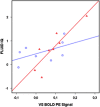The effects of life stress and neural learning signals on fluid intelligence
- PMID: 25142177
- PMCID: PMC4311068
- DOI: 10.1007/s00406-014-0519-3
The effects of life stress and neural learning signals on fluid intelligence
Abstract
Fluid intelligence (fluid IQ), defined as the capacity for rapid problem solving and behavioral adaptation, is known to be modulated by learning and experience. Both stressful life events (SLES) and neural correlates of learning [specifically, a key mediator of adaptive learning in the brain, namely the ventral striatal representation of prediction errors (PE)] have been shown to be associated with individual differences in fluid IQ. Here, we examine the interaction between adaptive learning signals (using a well-characterized probabilistic reversal learning task in combination with fMRI) and SLES on fluid IQ measures. We find that the correlation between ventral striatal BOLD PE and fluid IQ, which we have previously reported, is quantitatively modulated by the amount of reported SLES. Thus, after experiencing adversity, basic neuronal learning signatures appear to align more closely with a general measure of flexible learning (fluid IQ), a finding complementing studies on the effects of acute stress on learning. The results suggest that an understanding of the neurobiological correlates of trait variables like fluid IQ needs to take socioemotional influences such as chronic stress into account.
Figures



References
Publication types
MeSH terms
Grants and funding
LinkOut - more resources
Full Text Sources
Other Literature Sources
Medical

